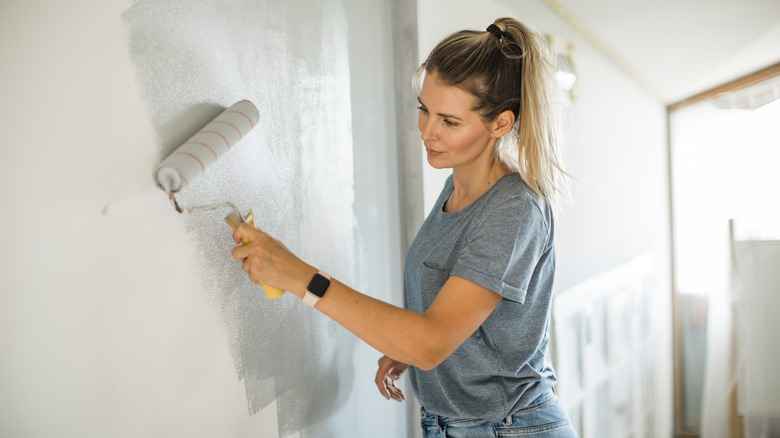The Best Way To Paint A Wall With A Roller According To Professionals
Some DIYers can't wait to get involved with a budget-friendly renovation, a piece of furniture they can build, or a roller they can drench in a new paint color. They're so enthusiastic that they plunge into the task at hand... maybe without enough research about how to work efficiently and achieve professional-looking results. Thankfully, the online world gives us easy access to pros, including painters with advice about best practices. General contractor and home renovation expert Jeff Thorman advises us not to wear ourselves out by hand-holding a paint roller, but to use a pole, an extension, and floor-to-ceiling strokes for seamless walls.
There are a few things that happen with a hand roller when you're trying to cover an entire room. Because you're your reach only extends a couple of feet, you've likely started painting in the middle of the wall in the short strokes you can manage. You're putting your whole body into the job just to exert enough pressure to get a sufficient amount of paint on the wall. You may also not be working in a linear manner, up and down, but rather winging your paint out in all directions, then getting on a ladder to continue this haphazard pattern above. Not only will you burn out from exhaustion, you'll use too much paint, and this method is going to result in a patchy, piecemeal mess.
How to get a smooth finish using a roller the right way
To prevent this from happening, Thorman says, "Professionals use a pole and an extension. That gives us the ability to use more pressure... to get an even coat with a lot less paint." A pole is probably the best investment you'll make as a DIY painter. You'll reduce a lot of unnecessary physical exertion and get a superb-looking wall. What could be better than that?
Once you've dipped your roller into the paint — don't oversaturate it, it shouldn't be dripping — Thorman recommends you step back a bit, position your roller in the center, making a stroke straight up to the top, then come all the way down to the bottom. Continue in these long strips, moving slightly to the right or left to cover the wall. Another TikTok user, @rolfeypaints says, "This is going to dry solid because you're not doing little patches here and there. You're always going to paint on a wet edge... so it's all going to blend." Remember, the paint needs enough time to dry completely, before you move on to other aspects of decorating.
